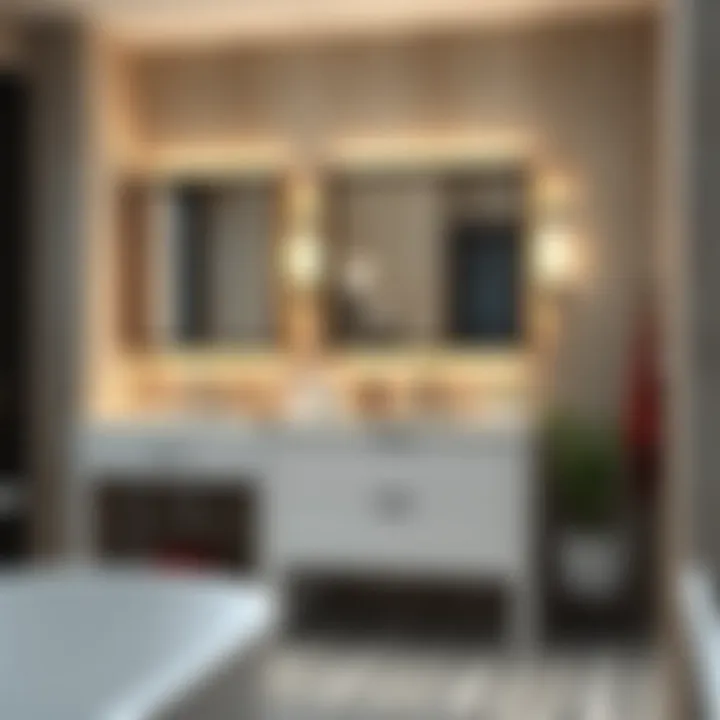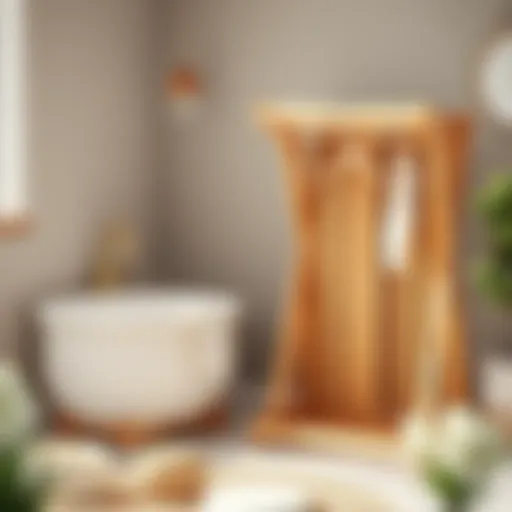Maximizing Functionality in Compact Bathroom Vanities


Intro
In the realm of home design, the bathroom often gets relegated to the decorative backseat. However, it's a pivotal part of living comfort. It’s where we start and end our days, and in today’s urban spaces, it’s becoming increasingly challenging to fit everything we need into often tiny areas. Precisely here is where the concept of bathroom vanities comes into play. They’re not merely pieces of furniture; they serve a dual role of style and practicality, especially in compact bathrooms.
This article will dive deep into workable solutions for integrating bathroom vanities into snug spaces. It’s crucial to recognize that with the right design choices, even a small bathroom can feel spacious and clutter-free. The aim is to furnish homeowners and interior designers with comprehensive insights to streamline functionality without sacrificing aesthetics. We’ll explore various design options, trendy styles, smart storage solutions, and layout guides to optimize your bathroom.
So whether you’re a homeowner looking to revamp your space or a designer mapping out a small area for a client, understanding the nuances of bathroom vanities is key. Let’s get into it.
Understanding the Necessity of Space Efficiency
In today’s home design landscape, the emphasis on space efficiency has become more than just a trend; it's a necessity, particularly in areas like the bathroom. With the average size of bathrooms shrinking, understanding how to optimize every square inch becomes crucial for homeowners, interior designers, and DIY enthusiasts alike. This section delves into why effective space utilization is paramount when selecting bathroom vanities for compact spaces.
Defining Tight Spaces in Bathroom Design
When discussing bathroom design, the term "tight spaces" often refers to those smaller bathrooms that can feel cramped or claustrophobic if not designed thoughtfully. Typical features may include limited floor area, compact layouts, and reduced pick for placements of fixtures and furniture. For instance, a bathroom measuring only five by eight feet can pose serious challenges when trying to incorporate traditional vanities that occupy considerable space.
Tight spaces may also include half-baths and powder rooms, which usually lack extensive storage or counter space. The goal, therefore, is to define these spaces accurately, which hinges on understanding the dimensions and flows of movement within the bathroom. By recognizing what constitutes a tight space, homeowners can approach their design choices with clarity and intent, ensuring both functionality and comfort do not fall by the wayside.
Importance of a Functional Vanity
The bathroom vanity stands out as a linchpin in any bathroom design. In tight spaces, this piece of furniture plays an even larger role, as it can significantly affect the overall usability and aesthetic of the area. It’s not just about having a sink—it's about how well that vanity integrates into the limited space, providing necessary storage and maximizing accessibility.
A functional vanity occupies a delicate balance between style and necessity. It should reflect personal taste while also serving practical needs, such as providing a surface for daily routines and sufficient storage for toiletries. A thoughtfully designed vanity—be it wall-mounted or a pedestal variety—ensures that users are not left fumbling for space while trying to complete their personal care rituals.
"A well-placed vanity is not just a piece of furniture; it's a pivotal player in enhancing both the form and function of small bathrooms."
In tight layouts, incorporating features such as open shelving or multi-functional cabinets can enhance the ease of use. Thus, thoughtfully considering the design and positioning of a vanity not only addresses space constraints but also adds to the overall user experience via increased organization and accessibility.
In summary, succeeding in maximizing space efficiency in bathroom design begins with recognizing what tight spaces entail and acknowledging the critical role a functional vanity plays in that equation. With a clear understanding, homeowners can make informed decisions that elevate the functionality of even the most constrained environments.
Dimensions and Measurements
When considering the integration of bathroom vanities into tight spaces, precise dimensions and measurements play a crucial role. Understanding how to navigate the limited area can truly make or break your design aspirations. A well-thought-out vanity not only complements your aesthetic but also maximizes the space’s functionality, making everyday routines smoother and more enjoyable.
Standard Vanity Sizes vs. Compact Options
Bathroom vanities come in a variety of sizes, each tailored for specific needs and spaces. Standard vanity sizes typically range from 24 inches to 72 inches in width, catering to traditional bathrooms with ample square footage. However, these dimensions can quickly encroach upon the already constrained environment of a small bathroom. Here’s where compact options come into play.
Compact vanities, usually between 18 inches and 36 inches wide, are designed to fit snugly into tighter spaces. They often feature clever design elements, such as built-in shelves or multi-purpose accessories, to optimize available room. The choice between standard and compact is influenced not just by measurements but also by the existing layout of the space. In a cozy area, it’s crucial to select a vanity which allows room for movement and access to other fixtures without creating a bottle-neck of sorts.
Measuring Your Space Accurately
Getting the measurements right can be like finding a needle in a haystack, especially in tight spaces. You want to ensure that every inch is accounted for, which demands a precise approach. Here’s a handy method to get it done:
- Use a Tape Measure: Grab a good-quality tape measure. Measure your wall space where the vanity will sit. Pay attention to the height, width, and depth.
- Account for Fixtures: Don’t forget to factor in other elements like toilets, showers, and doors. Leave at least 24 inches in front of the vanity for comfortable use;
- Check for Wiring and Plumbing: Look for any existing plumbing or electrical outlets. These can dictate where your vanity should or even can go. Sometimes, a little creative thinking can help in finding the optimal spot for your new addition.
- Consider Door Swing: Assess how the cabinet doors or drawers will function in the space. It’s no good to have a slick, new vanity that you can’t open!
"The right measurements essentially safeguard against clutter while enhancing the bathroom's overall efficiency."
In closing, investing time in dimensions and measurements before purchasing a vanity sets the course for a smoother renovation. The balance between aesthetic choices and space optimization is delicate, but through meticulous planning, you can ensure that your bathroom not only looks great but feels great too.
Choosing the Right Style
Selecting the appropriate style for bathroom vanities is crucial, particularly in tight spaces where every inch counts. The style of a vanity not only affects the overall aesthetics of the bathroom but also influences functionality. A well-chosen vanity can enhance the atmosphere of even the smallest bathrooms. It can blend seamlessly with other decor elements, thus creating a unified, inviting environment. Therefore, understanding different styles and their respective impacts on both form and function is paramount for anyone aiming to maximize their bathroom's potential.
Sleek Modern Designs
Modern designs emphasize clean lines and minimalism. This style is particularly advantageous in compact bathrooms, as it prioritizes efficiency without sacrificing elegance. Sleek modern vanities often come with built-in storage solutions that capitalize on vertical space, making them indispensable for small areas. Materials like frosted glass or polished metal complement this aesthetic, while soft-close drawers and hidden compartments further enhance functionality.
Characteristics of sleek modern designs include:
- Materials: Typically utilize materials that are easy to maintain, such as quartz or synthetics, which provide durability alongside style.
- Color Schemes: Neutral tones, such as whites and grays, create an illusion of spaciousness.
- Hardware: Often features discreet, integrated handles or push-to-open mechanisms, maintaining the clean look.
When considering a modern design, think about how it integrates with your existing decor. Modern vanities can either stand out as a focal point or recede into the background, depending on color and material choices.


Timeless Classic Options
Classic styles bring a sense of permanence and tradition to any space. These vanities often feature ornate details, molding, and rich wood finishes that may evoke a feeling of luxury. In smaller bathrooms, a classic vanity can add character and warmth, creating a cozy atmosphere.
Elements typical of classic designs include:
- Wood Enrichments: Those often include cherry, mahogany, or oak, lending timeless character.
- Decorative Details: Raised panels, intricate carvings, and antique-style hardware reflect elegance.
- Color Palette: Deep, warm colors coexist harmoniously with lighter hues, making it possible to play with contrasts effectively.
While opting for a classic style, it’s essential to be mindful of scale. An overly bulky vanity can overwhelm a small bathroom, so proportionality is key.
Material Considerations
When it comes to bathroom vanities, the choice of material is pivotal, especially in tight spaces. The materials you select can have a profound impact on both functionality and aesthetics. A vanity made from the right material not only serves as a pivotal storage solution but also enhances the overall visual appeal of a compact bathroom. Opting for durable materials that withstand the challenges of a humid environment is vital to ensure longevity while maintaining beauty.
Moreover, choosing the right materials can affect the ease of maintenance. In small areas, dust and moisture can accumulate quickly, so selecting materials that are easy to clean can save time and effort in the long run. Furthermore, the weight of the materials can also pose a consideration for structural safety in compact areas, making choices like lightweight composites appealing.
Popular Vanity Materials
When you step into the world of bathroom vanities, you’ll find a palette of materials, each with its benefits and drawbacks:
- Wood: A classic choice that brings warmth and character. It can be stained or painted to fit various styles, but remember, it needs to be sealed well to combat moisture.
- Laminate: Known for its affordability and versatility, laminate can mimic the look of wood or stone. It's also quite low maintenance, making it ideal for busy bathrooms.
- Solid Surface: Materials like Corian offer seamless designs and are resistant to stains. They are incredibly durable, making them a favorite choice for compact spaces where functionality is key.
- Quartz and Stone: These are elegant choices that add luxury. While heavier and more expensive, they provide a timeless look. Ensure that the vanity design accounts for the weight in smaller structures.
- Metal: Though less common, metal vanities can add a modern touch. They’re especially suitable for industrial-style bathrooms but can show fingerprints readily.
Each of these materials carries a different price point, aesthetic appeal, and level of durability which needs careful consideration based on individual needs and bathroom size.
Durability vs. Aesthetics
Choosing between durability and aesthetics is often a tug-of-war when selecting bathroom vanity materials. It's crucial to strike the right balance. While you may be drawn to the elegance of a marble countertop, if it can't withstand daily wear and tear or constant exposure to moisture, the short-term beauty could lead to long-term disappointment.
- Durability is non-negotiable in a high-use area like a bathroom. Look for materials that can handle humidity, resist scratches, and can be cleaned with ease.
- Aesthetics, on the other hand, play a major role in the enjoyment of your space. A well-designed vanity that complements the bathroom will not only create a welcoming environment but can also increase property value.
It's essential to think about the long-term picture. For example, a highly aesthetic vanity that requires frequent repairs or replacement may not be the best investment, particularly in a small bathroom.
In the end, consider materials that combine style with robust functionality. An example might be a laminate vanity with a wood-like finish, offering the look of wood without the constant upkeep. In essence, the right choice enhances both the beauty and the everyday practicality of your small bathroom.
Storage Solutions for Compact Vanities
When faced with the challenge of a tight bathroom, the right storage solutions can make all the difference. A well-designed vanity not only serves as a central aesthetic element in a small bathroom but also plays a crucial role in maximizing functionality. Inadequate storage can turn an otherwise efficient space into a cluttered and chaotic environment, making it essential to think creatively about how to incorporate storage into your compact vanity design.
Key Elements and Benefits
Efficient storage solutions can transform available space, allowing you to keep your essentials organized without crowding the area. When you carefully consider how to attack the storage issue, it results in increased accessibility and a more serene atmosphere.
Here are some considerations to keep in mind when thinking about storage solutions for compact vanities:
- Space Limitations: Always keep in mind the dimensions of your bathroom when selecting storage options. Too bulky of a cabinet can overwhelm a small bathroom.
- Multi-functionality: Look for designs that offer multiple uses. For example, a vanity with built-in shelves or mirrors can save you from needing additional furniture.
- Accessibility: Easy access is vital. Items that require constant use should be positioned for effortless retrieval, while less frequently used items can be stored further away.
"Maximizing space isn't about squeezing in more items, rather, it's about strategic placements and smart choices."
Incorporating Cabinets and Drawers
One of the most effective methods of improving storage in a compact bathroom is by incorporating cabinets and drawers into your vanity. These components can provide hidden storage that keeps your bathroom looking tidy.
When selecting cabinets, opt for designs that feature soft-close mechanisms and sturdy construction. These will not only enhance usability but also add a hint of luxury. Drawers should be thoughtfully planned; deep drawers are ideal for bulky items, while shallower ones can hold smaller accessories. For better organization:
- Use drawer dividers to separate toiletries from cosmetics.
- Label your containers to find what you need at a glance.
Take into consideration cabinets that extend to the ceiling if your height allows. This maximizes not just the storage capability but can also give the illusion of a higher ceiling, enhancing the feeling of spaciousness.
Utilizing Vertical Space Effectively
In small bathrooms, thinking vertically can provide extra storage without taking up precious floor area. By making use of wall-mounted cabinets and shelves, you can keep items off the ground while maintaining ease of access.
Consider these strategies:
- Floating shelves: They are a fantastic way to display decorative items or essential toiletries. Not only do they save floor space, but they also maintain a clean and airy feel.
- Tall, narrow cabinets: These can be slotting neatly into corners or beside the vanity. With a design that draws the eye up, it creates an impression of space while maximizing storage.
- Pegboards or hooks: Engage your creativity by using pegboards to organize commonly used items like towels and toiletries.


Innovative Organizational Accessories
If cabinets and drawers provide the foundation for storage, then innovative organizational accessories can enhance that foundation significantly. These accessories add efficiency and can be tailored to your specific needs.
Here are a few must-consider items:
- Stackable bins: These can be utilized in cabinets and on countertops. They offer flexibility and can be rearranged to suit your changing organizational needs.
- Pull-out trays: If drawers are too deep, having sliding shelves can help a lot to give you easy access to items tucked in the back.
- Tray organizers: These can be used to hold cosmetics, jewelry, or skin-care products, making them easy to find.
Incorporating these accessories can declutter the space effectively and make your daily routine smoother than ever.
By integrating thoughtful storage solutions, you not only enhance the functionality of your compact vanity but also create a more pleasant and organized bathroom space. The importance of strategic planning cannot be overstated; a well-organized bathroom can become a serene retreat amidst the chaos of daily life.
Placement and Layout Tips
When it comes to bathroom vanities in spaces that might get crowded, placement and layout are crucial. Getting these two right can make all the difference between a claustrophobic experience and a sanctuary of efficiency and style. A well-thought-out layout means the difference between tripping over your partner’s shoes and smoothly gliding through your morning routine.
This section will cover optimal positioning for your vanity as well as essential considerations for flow and functionality. Each point made here isn’t just a suggestion; it's a step toward transforming a tight spot into one that works.
Optimal Positioning in Small Bathrooms
Choosing where to place your vanity is like deciding on the best seat at a concert; a good view is everything. For smaller bathrooms, this involves assessing available wall space, ensuring that the vanity doesn’t block pathways or doors, and taking full advantage of available natural light.
Here are a few considerations for positioning your bathroom vanity:
- Wall-mounted vanities: These can be game changers. Elevating the vanity off the floor not only makes the space appear more expansive, but it also allows for cleaning underneath easily.
- Corner vanities: If you’re really short on space, a corner unit makes excellent use of an otherwise wasted area. This option can be particularly stylish, especially if you embrace a modern or eclectic aesthetic.
- Keep proportions in mind: A huge vanity can dwarf a small bathroom. Look for compact designs that fit the scale of your space. A narrow sink can provide ample room for grooming without overwhelming the area.
- Mirror positioning: Don’t forget about the mirror. Placing it opposite a window can reflect light back into the room, making it feel larger, while also being functional.
Placement is about much more than just aesthetics; it also impacts how you move in your space. The vanity should feel integral to the bathroom, not an obstacle that disrupts flow.
Considerations for Traffic Flow
Understanding how people move through a room is fundamental when placing your vanity. The last thing you want is to have someone bumping into the cabinet every time they step out of the shower. Think about the overall traffic flow in the bathroom before committing to any design.
Here are some indispensable points to consider:
- Clear pathways: Aim for at least 30 inches of clearance in traffic areas. This distance allows enough space for movement without feeling cramped or pinched.
- Bathroom zones: Think about different zones in your bathroom—grooming, bathing, and dressing. Give careful thought to how people will move within these areas without stepping on one another's toes.
- Multiple users: If you often share the space with family or roommates, consider whether the layout accommodates multiple users at the same time. A layout that allows one person to use the sink while another is getting ready can save everyone time.
- Door swings: Pay attention to how cabinet doors and the bathroom door swing open. Make sure they don't clash, which could result in a game of awkward maneuvers.
Ultimately, the aim is to ensure a seamless flow throughout the bathroom. A good layout should prioritize functionality while maximizing the small space you have. The right design can elevate an ordinary bathroom into an efficient and stylish retreat.
A thoughtfully positioned vanity can seamlessly integrate both form and function, ensuring that even the smallest spaces feel grand.
By considering placement and layout carefully, you're setting the stage for a bathroom that's not just functional but also a pleasant environment to start and end your day.
Lighting and Its Impact
Understanding how to effectively use lighting in small bathrooms is paramount in maximizing their space and functionality. Good lighting does not just enhance visibility; it can also truly transform the atmosphere of a compact area, making it feel more open and inviting. Lighting plays a vibrant role in accentuating the features of bathroom vanities, augmenting their functionality, and even influencing how colors and materials are perceived. When designed with thoughtfulness, proper lighting can be the bridge between a cramped space and a cozy retreat.
Effective Lighting Options for Tight Spaces
- Wall-mounted Fixtures: These are a prime choice for tight spaces. They can be installed at varying heights, providing necessary light while freeing up counter space.
- Recessed Lighting: This option works wonders for bathrooms with limited ceiling height. The fixtures sit flush with the ceiling, offering clean lines and avoiding the obstruction of hanging lights.
- Backlit Mirrors: A dual-functioning piece, backlit mirrors provide both illumination and the reflection necessary for grooming, making them especially beneficial over vanities in tight corners.
- LED Strip Lights: Flexible and functional, LED strips can be integrated underneath cabinets or along shelves. They create an ambient glow while also acting as accent lighting, highlighting the beauty of vanity space.
- Layered Lighting: Utilizing a combination of ambient, task, and accent lighting ensures a well-lit environment tailored for various activities—from applying makeup to a tranquil bubble bath.
Exploring these diverse lighting options will help you select those that not only fit your aesthetic but also serve practical purposes in limited spaces.
Enhancing Vanity Features with Lighting
Lighting around bathroom vanities can make or break the overall appeal and functionality. To achieve the perfect ambiance:
- Highlight Key Features: Use targeted lighting to draw attention to special design elements of the vanity, such as unique textures of cabinetry or stunning stone countertops. This creates focal points, making the area visually striking while underscoring the craftsmanship.
- Reduce Shadows: Strategic placement and type of bulbs are vital in reducing shadows, particularly around the face when looking into mirrors. Consider fixtures that illuminate from a higher angle or symmetrical wall sconces on either side of the mirror.
- Color Temperature: Aim for bulbs with a color temperature of around 2700K, which offers a warm, inviting glow. This light mimics natural daylight and can elevate the space significantly, making it feel warm yet spacious.
- Dimmable Lights: Installing dimmable options can adapt the lighting to different needs, whether it’s early morning preparation or a relaxing evening bath. Versatile lighting allows for more control over the ambiance.
"Thoughtfully placed lights make even the tightest of bathrooms luxurious."
By thoughtfully considering the integration of various lighting sources, you not only improve the usability of the vanity space but also enhance the overall aesthetic of your compact bathroom. Embracing well-planned lighting choices helps create a harmonious balance, where every time you step in, you feel right at home.
Accessibility and Comfort Considerations


Creating a bathroom that’s not just stylish but also comfortable and accessible is paramount, particularly when dealing with tight spaces. Accessibility considerations play a critical role in ensuring that all users—whatever their physical capabilities—can navigate this essential room with ease. By focusing on user-friendly design, homeowners can really enhance the day-to-day experience in their bathrooms.
When we talk about access, we need to think beyond just the width of the doorway. It includes relevant aspects like the height of the vanity, the placement of fixtures, and even the type of materials used. It’s about making the environment work for you rather than the opposite. Comfort too plays a major part; after all, no one wants to feel cramped or irritated in their own home. So, designing with accessibility in mind is all about balancing functionality and comfort, allowing for smooth movements and ease of use.
"In a world where spaces often feel confining, thoughtful design allows for freedom and ease, making even the smallest bathroom a pleasure to use."
User-Centric Design Principles
User-centric design is all about putting the needs of the user front and center. For bathrooms, this means considering who will use the space. Is it a family-friendly bathroom? Or maybe it's a serene escape just for adults? The difference in user needs can dictate how you approach the design.
- Height Considerations: A standard vanity might be perfect for average height individuals, but if your household has shorter or taller members, adjusting the height can make a significant impact.
- Clear Pathways: Ensuring there’s enough room to move around comfortably without bumping into things is key. A narrow room might seem like a challenge, but strategically placing fixtures can create a sense of spaciousness.
- Sensible Layout: Think about the intuition of movement. For instance, if someone is washing their hands while someone else is reaching for a towel, the layout should allow for this simultaneous use without obstructing either person.
Besides these aspects, integrative design methods can help cultivate an environment that caters to varied user experiences while maintaining the intent of style and functionality. Often, making small adjustments can lead to significant improvements in overall user satisfaction.
Incorporating Universal Design Features
Universal design is a step beyond basic accessibility. It promotes an inclusive environment where the varying needs of all users are taken into account without singling anyone out. This philosophy encourages a seamless integration between functionality and aesthetics, ensuring that spaces are welcoming for everyone.
For bathroom vanities in tight spaces, consider the following universal design features:
- Adjustable Height Vanities: As more homeowners become aware of varying needs, adjustable height vanities are gaining popularity. They allow users to easily modify the height depending on who is using the bathroom.
- Open Shelving Solutions: Open shelves eliminate the need for bending down and reaching into cabinets. This design is not just about function—it can also serve as a stylish way to display decorative items or handy toiletries.
- Non-Slip Flooring: Safety shouldn’t take a backseat to style. Using non-slip materials helps prevent accidents, which is crucial in wet areas like bathrooms.
Incorporating these features doesn’t just help with accessibility; they also create an atmosphere where everyone can feel comfortable and at ease. A practical bathroom leads to a more harmonious living space, underscoring the importance of thoughtful design. These principles are crucial, especially when dealing with limited space.
For more information on universal design features, you can explore resources on Universal Design Principles and how they apply to our home spaces.
Trends in Compact Bathroom Vanities
Exploring trends in compact bathroom vanities reveals how design and functionality are intertwined in today’s market. As living spaces shrink, finding efficient ways to incorporate stylish yet functional vanities into tight bathrooms has become paramount. Trends reflect a shift towards designs that maximize utility without compromising on aesthetics, making them essential for homeowners and designers alike.
Current Market Trends
In recent years, the bathroom vanity market has seen a shift toward smaller, more versatile models that blend function with style. One notable trend is the growth of modular vanities. These pieces can be customized to fit various layouts and personal preferences, allowing homeowners to make the most of limited space. Modular configurations can include interchangeable drawers and shelves, making it easier to organize bathroom essentials effectively.
Emphasis on sustainability is also carving a niche within this domain. Many manufacturers are committing to eco-friendly materials and finishes. Bamboo, reclaimed wood, and recycled composites are gaining popularity. This not only caters to environmentally conscious consumers but also adds a unique touch to the bathroom’s overall decor. Another emerging trend worth mentioning is the integration of advanced technology in vanities. Motion-sensor faucets and smart mirrors, which can display weather updates or assist with skincare routines, are becoming more common, providing both novelty and enhanced functionality.
"The design of compact bathroom vanities is now more about craftsmanship and unique features, reflecting personal style while meeting practicality needs."
Innovative Designs on the Rise
Innovative designs for compact bathroom vanities are reshaping the landscape of interior decor. One such development is the resurgence of floating vanities, which create the illusion of more floor space in small bathrooms. Elevating the vanity not only allows for easier cleaning but also offers a sleek, modern aesthetic.
Another trend gaining traction is the use of integrated sinks. Rather than a traditional separate sink bowl, many designers are now incorporating a seamless sink design that blends into the vanity countertop. This clean look not only streamlines the overall appearance but also simplifies cleaning and maintenance.
Moreover, geometric shapes and asymmetrical designs are gaining popularity as they move away from conventional symmetry. These fresh approaches create striking visuals while retaining vital storage elements—an aesthetic treat combined with practical benefits. Furthermore, bold colors and finishes are becoming more accepted in compact vanities, moving beyond neutral tones that have dominated the past. Dark hues or even vibrant colors can inject personality into a modest bathroom space.
In summary, the ever-evolving trends in compact bathroom vanities showcase a remarkable combination of style and function. Homeowners and designers must stay abreast of these trends to ensure that their designs not only meet today’s aesthetic standards but also serve the practical needs of efficiency and space optimization.
Closure: Making the Best Choice
In the realm of tight bathroom spaces, making the best choice regarding vanities can significantly shape both functionality and aesthetics. The decisions made in this regard influence how one navigates their daily routines and experiences the personal sanctuary that a bathroom should represent. A thoughtful approach to selecting the right vanity can make all the difference for homeowners and designers alike.
Summarizing Key Takeaways
When diving into the key aspects of optimizing compact bathroom spaces with suitable vanities, a few points stand out:
- Sizing Matters: Choosing compact or standard-sized vanities depends largely on the dimensions of your bathroom. Proper measurement is crucial in ensuring the vanity fits without crowding the space.
- Style Counts: Incorporate styles that align with your vision for the bathroom. Whether you lean towards sleek moderns or classic designs, the right vanity will harmonize with other elements in the room.
- Storage Solutions: Innovative storage can drastically enhance the utility of even the smallest vanities. Look for designs that include multiple cabinets, drawers, or units that utilize vertical space.
- Lighting Influence: The statement a vanity can make with the right lighting is profound. Layered lighting, from mirrored sconces to overhead fixtures, can transform the perceived size and ambiance of the area.
These takeaways underscore the necessity of a comprehensive understanding of the elements involved in selecting bathroom vanities for tight spaces.
Final Thoughts on Space Optimization
Deciding on the right vanity is more than just a choice of style; it’s about optimizing space for both practicality and comfort. Think of your bathroom as more than just a utilitarian zone; it is also a retreat where you start and end your days.
- Emphasizing functionality without sidelining aesthetic appeal is vital. A well-selected vanity can enhance the space, creating an illusion of openness while providing essential storage.
- Personalization is key; don’t shy away from mixing and matching styles or utilizing layered textures. This approach often breaks away the monotony and delivers both charm and functionality.
- Finally, staying informed about current trends can guide you toward practical solutions that elevate your small bathroom. Whether it's a floating vanity that maximizes floor space or innovative materials that better withstand moisture, these choices reflect a forward-thinking attitude towards home design.
In summary, a careful selection of a bathroom vanity for tight spaces not only maximizes functionality but also polishes the overall design. It serves as the nucleus around which the rest of the bathroom experience revolves. By focusing on the subtleties of size, style, and storage, you equip yourself with the right tools to create a sanctuary that doesn’t compromise on style, even in the tightest of quarters.
"The best bathroom vanities aren’t just furniture; they’re the heartbeat of a well-designed space."
Arming yourself with knowledge around these topics ensures that every inch of your bathroom is utilized effectively, creating an oasis tailored to your personal needs.







